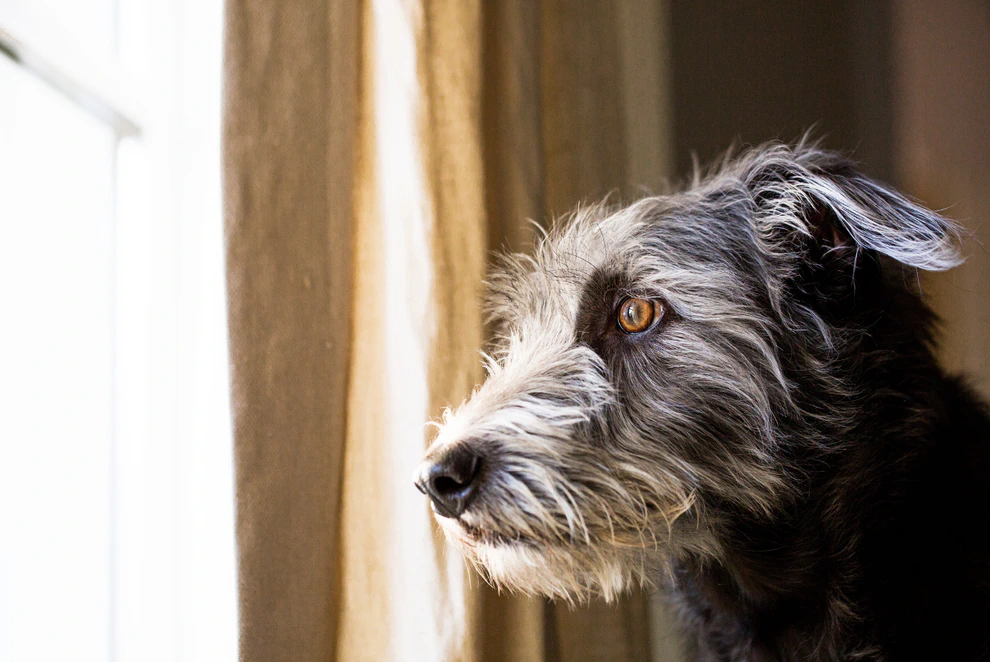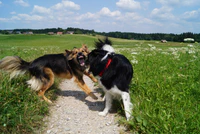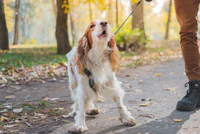Rethinking Separation Anxiety in Dogs: Fear, Frustration, and How We Can Help
While separation anxiety can manifest in ways that are distressing to both dogs and their guardians, understanding the root causes and the most effective treatment strategies can bring clarity, compassion, and real change. As a Clinical Animal Behaviourist, I regularly work with families navigating the emotional rollercoaster of this condition. In this article, we’ll explore what separation anxiety really is, what common misconceptions can hinder progress, and how we can better support our dogs and their humans.
What is Separation Anxiety?
Separation anxiety is not a single behaviour but rather an umbrella term for a collection of behaviours triggered by the absence of a guardian. It includes a range of distress responses such as barking, howling, destructive behaviour, house soiling, or attempts to escape the home. These behaviours are not signs of disobedience or being “spoiled” they’re distress signals from a dog who is genuinely struggling to cope with being alone.
These behaviours often begin the moment the guardian prepares to leave the house and can persist for the entire duration of their absence. In many cases, the dog exhibits physical signs of anxiety, such as pacing, drooling, or self-injury. Understanding these behaviours as communication rather than misbehaviour is essential to an empathetic and effective approach.
Separation anxiety in dogs is a complex and often misunderstood behavioural issue, affecting around 20% of dogs.
Fear vs. Frustration: Why the Distinction Matters Less Than We Think
A growing debate in canine behaviour science focuses on whether a dog experiencing separation-related issues is driven by fear or frustration. While some behaviours like scratching the hinge side of a door may suggest frustration, the reality is that dogs can experience both emotions simultaneously. Julie Naismith, a leading expert in this area, advises erring on the side of caution and treating cases as fear-based unless clear evidence suggests otherwise.
Why? Because assuming fear allows us to avoid underestimating the problem. Trying to pinpoint the exact emotion is only useful if it alters the treatment strategy. And in the majority of cases, it doesn’t. Desensitisation gradual exposure to increasing durations of alone time is still the foundation of effective treatment, regardless of whether fear or frustration is the primary emotion.
Desensitisation should be tailored to the individual dog’s pace, avoiding any steps that provoke anxiety. This method works best when it is accompanied by clear communication, emotional support for the guardian, and, when needed, collaboration with veterinary professionals who may assist with short-acting medication.
The Guardian’s Role in Recovery
It’s important to emphasise that dog guardians are not to blame for separation anxiety. This is a message that needs repeating, especially in a world where guardians often carry guilt over their pet’s emotional struggles. The truth is, most guardians do their best with the information they have and when they seek professional help, they’re demonstrating deep care and responsibility.
Dog guardians are not to blame for separation anxiety.
Recovery relies on a guardian’s consistency, patience, and emotional resilience. It’s not an easy path. That’s why behaviour plans must be practical and realistic, avoiding overwhelm while offering structured support. Simplified training protocols, clear expectations, and small achievable goals can make the process more manageable.
Hyper-attachment can complicate matters further. Some dogs form intense bonds with a single person, which makes them even more vulnerable when that person leaves. In such cases, expanding the dog’s circle of trust is key. Introducing other people gradually and associating them with positive experiences can reduce this over-reliance and help build a more balanced attachment pattern.
Prevention Through Puppy Socialisation
Being alone is not natural for dogs. Dogs are social animals that thrive on companionship, and historically, they’ve been selectively bred to live closely with humans. Therefore, leaving them alone for extended periods without preparation can be highly stressful.
One of the most effective preventative strategies is incorporating alone-time exposure into a puppy’s early socialisation period. Just like gradual exposure to other stimuli (e.g., traffic, people, sounds), safe and positive alone-time can teach puppies that solitude is not something to fear. This won’t guarantee immunity from separation anxiety, but it significantly improves their chances of coping well as adults.
Home-alone time should be included in every puppy socialisation checklist. This means starting with just a few seconds of separation and slowly increasing the duration while monitoring the puppy’s comfort levels. Puppies who learn that being alone is safe and temporary are better equipped for adult independence.
What We Can Do Better
Behaviour professionals and guardians alike can work toward better outcomes by making several key shifts:
Simplify training protocols: Overwhelming guardians with too many steps or complicated data collection can lead to non-compliance. Clear, concise plans with manageable goals work best.
Gamify the process: Turning training into a game or adding small rewards for progress (for both dog and guardian) can keep motivation high.
Use community and support networks: Peer support can be incredibly powerful. When guardians feel connected to others experiencing the same challenges, they’re more likely to persist.
Include alone-time exposure in puppy plans: Prevention is far easier than treatment. Let’s normalise preparing puppies for alone-time.
Focus on the dog’s experience: Labels like “fear-based” or “frustration-based” are secondary to understanding what the dog is actually feeling and communicating.
Summary
Separation anxiety is emotionally complex for everyone involved, but recovery is entirely possible. With compassionate, science-based guidance and a focus on both the dog and the human, significant improvements can be achieved. If your dog is struggling with being left alone, you are not failing they are not being difficult and you are not alone.
Let’s commit to shifting the narrative from blame and confusion to understanding and support. Behaviour change takes time, but with the right tools and an empathetic approach, you and your dog can move toward a calmer, more confident future.
Thank you for taking the time to learn how to support your dog’s behavioural health. Your commitment makes a world of difference in their life 🐾
If you’re struggling with separation-related behaviours, Bright Horse & Hound offers bespoke, in-home behavioural assessments and personalised training plans. With clinical expertise and ongoing support, we’ll help guide you and your dog through every step of the journey. Get in touch today and take the first step toward a calmer, happier dog.
5 Signs Your Dog May Be Struggling With Separation Anxiety
Is your dog struggling when left alone? You aren’t alone… 20% of dogs struggle with this…
Separation anxiety can be confusing, frustrating, and heartbreaking for both dogs and their humans. If you’re not sure what’s normal and what’s a red flag, my free guide, “5 Signs Your Dog May Be Struggling With Separation Anxiety” can help. It’s a quick, vet-trusted checklist that will help you recognise the early warning signs and understand what your dog might be trying to tell you.
Sign up below to get your copy and receive a gentle, supportive 6-part email series that walks you through how to help your dog feel calmer and more confident.
References
- Amat, M., Camps, T., Le Brech, S., & Manteca, X. (2014). Separation anxiety in dogs: The implications of predictability and contextual fear for behavioural treatment. Animal Welfare, 23(3), 263-266. [DOI: 10.7120/09627286.23.3.263]
- Flannigan, G., & Dodman, N. H. (2001). Risk factors and behaviours associated with separation anxiety in dogs. Journal of the American Veterinary Medical Association, 219(4), 460-466. [DOI: 10.2460/javma.2001.219.460]
- Dreschel, N. A. (2010). The effects of fear and anxiety on health and lifespan in pet dogs. Applied Animal Behaviour Science, 125(3-4), 157-162. [DOI: 10.1016/j.applanim.2010.04.003]




